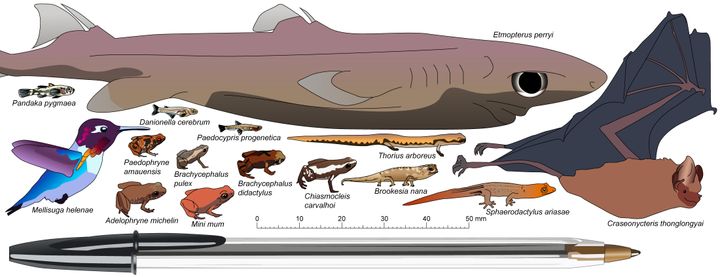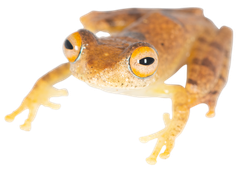Flea toads, dwarf pygmy goby fish and bumblebee bats: Researcher aims to solve the riddle of miniature animals
Just seven millimetres long, flea toads are among the smallest vertebrates on Earth. Despite their diminutive size, their organs and functions hardly differ from animals a thousand times larger. While examples of extreme miniaturisation abound in nature, just how these creatures get so small remains a scientific mystery. Now, a researcher from the University of Copenhagen has received DKK 11 million (roughly €1.5 m) from the European Research Council to get to the bottom of this phenomenon.

What do flea toads and smartphones have in common? Despite their innards having shrunken to extremes, their organs and components are the same as those found in much larger animals – and computers – yet still able to fit in their small "bodies". With regards to technology, we have long since become accustomed to things shrinking in stride with innovation. Though few consider the ability of animals to miniaturize – for them to get smaller while retaining the same well-functioning organs, senses and behaviour as animals hundreds of times larger – it happens everywhere in nature.
Flea toads, dwarf pygmy goby fish and bumblebee bats are just a few examples of vertebrates that have shrunk through evolution, without losing any of their basic physical characteristics. But what exactly happens in a vertebrate, right down to the genetic level, when evolutionarily, a species miniaturizes? And is there really anything preventing the smallest vertebrates from getting even smaller?
These are some of the questions that Dr. Mark D. Scherz from the Natural History Museum of Denmark will investigate over the next five years with the help of a DKK 11 million grant (roughly €1.5 m) from the European Research Council (ERC).
"Large animals are often the ones to grab our attention. But I think it to be just as fascinating how nature has managed to miniaturize the exact same vital organs and cram them into a less than one-centimetre-long frog. Today, we know surprisingly little about how it all happens, and I want to change that," says Mark D. Scherz.
Natures tech sector
Since its dawn, the tech industry has gradually shrunk the size of transistors in phones and computers to allow room for more of them and higher performance. Similarly, scientists believe that extreme miniaturisation is often associated with innovation and evolution in nature, without fully understanding it.
The new research project, GEMINI (Genomics of Miniaturisation in Vertebrates), is purposed with identifying exactly what happens in the DNA of vertebrates when they shrink. The project will thus develop a kind of genetic template for what happens as animals miniaturise.
"In several independent studies that looked at the genomes of miniaturized animals, a kind of clean-up and innovation takes place, where the genome becomes smaller. A lot of this happens in repetitive bits of the genome that we used to call ‘junk’ DNA. But some of it happens in other genes as well, which is what we need to learn more about," says the researcher.
In fact, it was previously believed that animal populations would constantly trend towards larger sizes as they evolved – the so-called "Cope’s rule". Today, however, it is known that this is not unequivocally true – and with good reason.
“Dyr kan ikke bare blive ved med at vokse sig større og større. På et tidspunkt sætter fysiologien - udveksling af varme, vand og ilt - en grænse, og det samme gør tyngdekraften. Derfor skal der være faser, hvor kropsstørrelsen reduceres, for at der overhovedet kan være en tendens til øget størrelse,” forklarer Mark D. Scherz og tilføjer:
”Vi tror også, at den lille størrelse kan være der, hvor de virkelig store innovationer sker, som vi så ser udbygget, når efterkommerne bliver større igen. Det gør disse miniaturiserede dyr særligt spændende at se på, når vi prøver at finde ud af, hvordan nyskabelser udvikler sig i naturen.”
T-Rex and Moby Dick steal the spotlight
According to Mark D. Scherz, the field of 'miniaturisation' has not been a high priority among scientists for decades. Indeed, some of the most recent groundbreaking results in the field date back to the 1990s. Instead, researchers have focused on large animals.
"Everyone’s attention is on blue whales and elephants. Any child you ask can tell you about the largest land mammal and the largest marine mammal and the largest dinosaur that has ever lived. But scaling up and getting bigger is not a big problem. It is a far more impressive feat to have practically everything in a twenty-three-tonne blue whale compressed into a seven-millimetre package," says the researcher.
But now, the researcher speaks of a renewed focus on animal miniaturisation – thanks in part to a number of spectacular recent finds. Earlier this year, researchers in Brazil discovered the world's smallest vertebrate, the flea frog, which measures just seven millimetres.
"We live at a time when probably the smallest vertebrates ever are around us, but they are too easy to overlook, so we just forget about them. This project will allow us to gain a genetic understanding of what controls this 'miniaturisation process' and investigate whether there is something that keeps animals from becoming even smaller," concludes Scherz.
About ERC Starting grants:
European Research Council Starting Grants are awarded to promising young research talents two to seven years after they have received their PhDs. Up to EUR 1.5 million will be allocated to ground-breaking research projects over a five-year period. Read more
Kontakter
Mark D. Scherz
Curator of Herpetology, Assistant Professor
Natural History Museum of Denmark
University of Copenhagen
+45 35 32 46 55
mark.scherz@snm.ku.dk
Michael Skov Jensen
Journalist and team coordinator
The Faculty of Science
University of Copenhagen
+ 45 93 56 58 97
msj@science.ku.dk
Billeder


Følg pressemeddelelser fra Københavns Universitet - Det Natur- og Biovidenskabelige Fakultet
Skriv dig op her, og modtag pressemeddelelser på e-mail. Indtast din e-mail, klik på abonner, og følg instruktionerne i den udsendte e-mail.
Flere pressemeddelelser fra Københavns Universitet - Det Natur- og Biovidenskabelige Fakultet
Old aerial photos give scientists a new tool to predict sea level rise3.7.2025 08:00:00 CEST | Press release
Researchers from the University of Copenhagen have gained unique insight into the mechanisms behind the collapse of Antarctic ice shelves, which are crucial for sea level rise in the Northern Hemisphere. The discovery of old aerial photos has provided an unparalleled dataset that can improve predictions of sea level rise and how we should prioritise coastal protection and other forms of climate adaptation.
Gamle luftfotos giver forskere nyt redskab til at forudsige havstigninger3.7.2025 08:00:00 CEST | Pressemeddelelse
Forskere fra Københavns Universitet har fået unik adgang til at forstå mekanismerne bag antarktiske ishylders kollaps, som er afgørende for havstigninger på den nordlige halvkugle. Et fund af gamle luftfotos har skabt et enestående datasæt, som kan forbedre vores forudsigelser af hvor meget havene stiger, og vores prioritering af kystsikring og andre klimatilpasninger.
Ny institutleder på IFRO: ”Faglighed og fællesskab går hånd i hånd”1.7.2025 10:49:17 CEST | Pressemeddelelse
Per Svejstrup er fra 1. august ansat som institutleder på Institut for Fødevare- og Ressourceøkonomi (IFRO). Den kommende leder træder ind i rollen med stor respekt for IFRO's faglige og kollegiale kultur med klare ambitioner for fremtiden.
Dangerous Variant of Salmonella Still Not Eradicated – Researchers Point to the Solutions1.7.2025 09:53:23 CEST | Press release
The infectious and multi-resistant cattle disease Salmonella Dublin can be fatal to both humans and animals and causes significant losses for farmers. Although Denmark has attempted to eradicate the disease since 2008, it has not yet succeeded. A study from the University of Copenhagen points to possible reasons – and the necessary solutions.
Farlig type salmonella er stadig ikke nedkæmpet i Danmark – forskere peger på løsningerne30.6.2025 09:54:03 CEST | Pressemeddelelse
Den smitsomme og multiresistente kvægsygdom Salmonella Dublin kan være dødelig for både mennesker og dyr og medfører desuden betydelige tab for landmændene. Selvom Danmark har forsøgt at udrydde sygdommen siden 2008, er det ikke lykkedes. Et studie fra Københavns Universitet peger på den mulige årsag og de nødvendige løsninger.
I vores nyhedsrum kan du læse alle vores pressemeddelelser, tilgå materiale i form af billeder og dokumenter samt finde vores kontaktoplysninger.
Besøg vores nyhedsrum